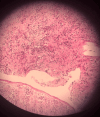Recurrent Hypoglycemia in a Non-diabetic Female: A Case Study on Doege-Potter Syndrome
- PMID: 39077286
- PMCID: PMC11283929
- DOI: 10.7759/cureus.63329
Recurrent Hypoglycemia in a Non-diabetic Female: A Case Study on Doege-Potter Syndrome
Abstract
Solitary fibrous tumors (SFT) are mesenchymal cell tumors that may arise from any site throughout the body. A small percentage of patients with SFT develop non-islet cell tumor-induced hypoglycemia (NICTH), eponymously termed Doege-Potter Syndrome (DPS). DPS is characterized by severe, refractory hypoinsulinemic hypoglycemia. Diagnosis of SFT is dependent on histologic findings and immunohistochemistry (IHC). NAB2-STAT6 gene fusions are pathognomonic for SFT but may be difficult to identify in routine cytogenetic studies. STAT6 IHC is a highly sensitive and specific surrogate for the NAB2-STAT6 gene fusion. Total resection of the tumor remains the gold-standard definitive treatment of SFT of the pleura. Palliative tumor debulking is recommended if total resection is not feasible. We here report a case of DPS in a 73-year-old female, managed with palliative care.
Keywords: endocrinology; hypoglycemia; recurrent hypoglycemia; solitary fibrous pleural tumour; solitary fibrous tumor.
Copyright © 2024, Mohammed et al.
Conflict of interest statement
Human subjects: Consent was obtained or waived by all participants in this study. Conflicts of interest: In compliance with the ICMJE uniform disclosure form, all authors declare the following: Payment/services info: All authors have declared that no financial support was received from any organization for the submitted work. Financial relationships: All authors have declared that they have no financial relationships at present or within the previous three years with any organizations that might have an interest in the submitted work. Other relationships: All authors have declared that there are no other relationships or activities that could appear to have influenced the submitted work.
Figures




References
-
- Das tuberkelähnliche Lymphadenom (der Cytogene oder Reticulirte Tuberkel) Wagner E. Arch Heilk. 1870;11:497.
-
- Solitary fibrous tumors of the thorax: nomenclature, epidemiology, radiologic and pathologic findings, differential diagnoses, and management. Chick JF, Chauhan NR, Madan R. AJR Am J Roentgenol. 2013;200:0–48. - PubMed
-
- Solitary fibrous tumor: molecular hallmarks and treatment for a rare sarcoma. Smrke A, Thway K, H Huang P, Jones RL, Hayes AJ. Future Oncol. 2021;17:3627–3636. - PubMed
-
- Solitary fibrous tumors of the pleura: eight new cases and review of 360 cases in the literature. Briselli M, Mark EJ, Dickersin GR. Cancer. 1981;47:11–2678. - PubMed
-
- Localized benign and malignant fibrous tumors of the pleura: a clinicopathologic review of 223 cases. England DM, Hochholzer L, McCarthy MJ. https://journals.lww.com/ajsp/abstract/1989/08000/localized_benign_and_m.... Am J Surg Pathol. 1989;13:640. - PubMed
Publication types
LinkOut - more resources
Full Text Sources
Research Materials
Miscellaneous
